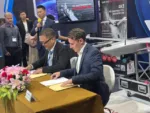The U.S. Federal Aviation Administration (FAA) has launched a new pilot program aimed at accelerating the deployment of electric vertical takeoff and landing (eVTOL) aircraft—commonly referred to as “air taxis.” While primarily focused on commercial urban air mobility (UAM), the initiative holds significant implications for dual-use technologies with potential military applications in logistics, reconnaissance, and tactical mobility.
FAA Launches Air Taxi Integration Pilot Program
On September 12, 2025, the FAA formally announced the launch of its Air Taxi Integration Pilot Program (ATIPP), designed to streamline regulatory pathways for eVTOL aircraft operations in U.S. airspace. The initiative will involve collaboration with local governments, industry stakeholders such as Joby Aviation and Archer Aviation, and federal agencies including NASA. The goal is to identify operational challenges and develop scalable frameworks for certifying aircraft types, pilot training standards, vertiport infrastructure requirements, and integration into existing air traffic control systems.
According to the FAA’s statement, ATIPP will run through 2028 across multiple metropolitan areas including New York City, Los Angeles, Chicago, Dallas–Fort Worth, and Miami. These locations were selected based on existing infrastructure readiness and projected demand for urban air mobility services.
Key Industry Players Involved
Several leading eVTOL developers have been tapped to participate in ATIPP:
- Joby Aviation: Backed by Toyota and the U.S. Department of Defense’s Agility Prime program under AFWERX. Joby’s S4 aircraft has already conducted test flights with USAF observers.
- Archer Aviation: Recently partnered with the U.S. Air Force under a $142 million contract for its Midnight aircraft platform.
- Wisk Aero: A Boeing-backed autonomous eVTOL developer focusing on pilotless operations.
- Lilium: A German company developing a ducted-fan eVTOL jet with longer range capabilities; also exploring defense-sector use cases in Europe.
The inclusion of these firms reflects growing alignment between civilian UAM development and defense-sector interest in distributed aviation architectures that reduce reliance on traditional runways or forward operating bases.
DARPA and DoD Interest in Dual-Use eVTOL Capabilities
The Department of Defense has long shown interest in electric or hybrid-electric VTOL platforms due to their potential for rapid deployment without dependence on fixed infrastructure. Programs such as DARPA’s X-Plane initiative (e.g., Aurora Flight Sciences’ XV-24A LightningStrike) laid early groundwork for distributed propulsion concepts now seen in commercial eVTOLs.
The U.S. Air Force’s Agility Prime effort—launched in 2020—explicitly sought to accelerate commercial eVTOL development by providing flight test support and early procurement contracts. Joby Aviation became one of its flagship participants. The Army has also explored small-scale cargo VTOL platforms under its Future Vertical Lift (FVL) umbrella.
Potential military use cases include:
- Tactical resupply missions over contested terrain without requiring large helicopters or vulnerable convoys.
- Austere medevac operations, particularly using autonomous or remotely piloted variants.
- ISR roles, especially if equipped with EO/IR sensors or SIGINT payloads on quiet electric platforms.
- Base-to-base personnel transport, reducing helicopter fleet burden while improving responsiveness.
Civil-Military Synergies in Infrastructure Development
The ATIPP rollout includes plans for temporary vertiport installations co-located at existing heliports or airports. This infrastructure could be dual-purposed during emergencies or military contingencies where rapid aerial logistics are needed—for example during disaster response or homeland defense scenarios involving National Guard units.
NATO allies have also begun exploring similar civil-military convergence models. The UK Ministry of Defence is working with Vertical Aerospace on potential use cases; Germany’s Bundeswehr has evaluated Lilium Jet variants for medical evacuation trials; France’s DGA is monitoring Airbus’ CityAirbus NextGen platform closely as part of future battlefield mobility concepts under SCORPION doctrine evolution.
Regulatory Challenges Ahead
The FAA faces several hurdles before full-scale air taxi operations can be realized:
- Lack of standardized certification categories specific to eVTOLs—current frameworks are adapted from rotary-wing rulesets not optimized for distributed propulsion systems.
- Pilot licensing requirements remain unclear—especially regarding single-pilot vs autonomous operation thresholds under Part 135 rulesets.
- Spectrum allocation issues may arise as more autonomous systems rely on high-bandwidth C2 links vulnerable to interference or jamming—a concern shared by DoD stakeholders operating in contested EM environments.
The FAA aims to publish draft guidance on vertiport design standards by mid-2026 and finalize new certification pathways by late 2027—a timeline that aligns roughly with IOC targets set by leading OEMs such as Joby (2026–27).
Operational Testing Timelines and Milestones
A number of key milestones are expected over the next three years:
- 2025 Q4: Initial flight trials begin at designated ATIPP sites using certified pre-production aircraft from Joby and Archer under experimental type certificates (XTC).
- 2026 Q3: Vertiport demonstration events held jointly with NASA’s Advanced Air Mobility National Campaign Phase III exercises at Dallas Fort Worth International Airport (DFW).
- 2027 Q1: Limited commercial passenger trials begin under waivers granted via Special Federal Aviation Regulation (SFAR) authority pending final rulemaking completion.
If successful, these demonstrations could serve as templates not only for domestic commercial services but also expeditionary deployments abroad where rapid aerial insertion/extraction capabilities are needed without conventional runways—in line with evolving Joint All-Domain Operations (JADO) doctrine within U.S. Indo-Pacific Command (INDOPACOM).
Implications for Global Defense Posture & Procurement Strategy
The convergence between civilian UAM programs like ATIPP and defense-sector interests signals a shift toward modular aviation ecosystems that blur traditional lines between manned/unmanned systems—and between civil/military procurement channels. This could lead to faster fielding cycles via non-traditional acquisition pathways such as Other Transaction Authority (OTA) contracts or Cooperative Research And Development Agreements (CRADAs).
Nations investing early in dual-use vertical lift technologies may gain strategic advantages across domains—from urban ISR coverage during gray-zone conflicts to humanitarian assistance/disaster relief missions requiring agile lift capacity without forward basing dependencies. The Pentagon’s current focus on contested logistics across anti-access/area denial (A2/AD) environments makes this capability increasingly relevant—not only tactically but strategically across Indo-Pacific flashpoints like Taiwan Strait scenarios or South China Sea littoral zones where distributed basing is essential due to missile threats against large fixed installations.
Conclusion: From Urban Commutes to Tactical Edge Mobility?
The FAA’s new pilot program marks more than just an administrative milestone—it represents an inflection point where emerging aerospace technologies developed for civilian markets may rapidly transition into operational relevance within military contexts. As testing progresses through the late 2020s, expect increased coordination between federal regulators like the FAA/NASA duo and defense innovation arms such as DARPA/AFWERX/DOD CIO offices driving autonomy policy frameworks aligned with national security imperatives.









